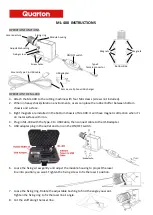
Figure 1 - Domestic battery only
5
Connect the shunt cable to the display unit as shown on Figure 1,
below, using the terminal block supplied. Be careful to connect the
wires exactly as shown, noting that the black and white wires are
joined at the shunt connection, and are connected separately at the
instrument end of the cable.
6
Fit the instrument into the panel, fit the stainless clamp over the
studs, fit and tighten the two wing nuts finger tight only. It is
important that the O-ring rubber seal makes good contact with the
panel to prevent water getting behind the unit and entering the
cavity behind the panel.
7
It is good practice to run the cables vertically downwards from the
unit, even if they later have to rise to connect to the vessel's
supplies. Doing so prevents any water that might get onto the cables
from running back along the cables and into the unit.
8
Ensure that all loads are switched off
9
Disconnect the NEGATIVE terminal from the battery and connect to
the shunt as shown on Figure 1. Ensure it is positioned where it
cannot come into electrical contact with other parts, and ensure it
will remain dry and free from contaminants. Also note that the
shunt can get warm when heavy currents flow, so ensure it is
secured in a position where its heat cannot affect other parts. TAKE
CARE TO AVOID OVER-TIGHTENING THE CONNECTION TO THE
SHUNT.
10
Connect the Black and White wires and Yellow wire to the shunt as
shown on Figure 1.
RED
RED
BLACK
*
BLACK
WHITE
*
Cables
supplied
Original
cables
WHITE
YELLOW
YELLOW
YELLOW
*
Black & White
MUS T NO T be
joine d a t thi s end.
V&A
TIME
A-Hr
ILLUM
BM
ORANGE
SHUNT
DOMESTIC
BATTERY OR
BATTERIES
-
+
FUSE
NEGATIVE
TO ALL DOMESTIC
LOADS AND GENERATORS
5-metre
CABLE
POSITIVE
TO ALL DOMESTIC
LOADS & GENERATORS
No other connection
should be made to
this post
Page 2






























